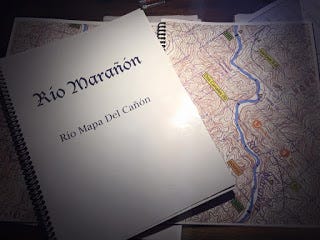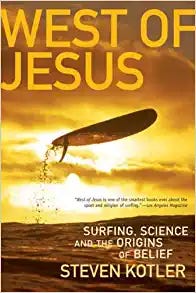
(In my last post, myself and fifteen intrepid adventurers found ourselves up to our armpits in darkest Peru lashing down gear on six rafts at the put-in for a 24-day expedition down the Grand Canyon of South America - the Rio Maranon.)
So there we were. In a working gravel pit. Sweltering under the relentless onslaught of the equatorial sun while lashing gear for the next three weeks, and then some, onto our Chinese-manufactured, inflatable rafts which resembled aircraft carriers in size and maneuverability.
Despite the commotion of heavy machinery, we were as excited and giddy as a bunch of hogs wallowing in a mud hole. We were prepping to run a river in Peru!
Unfortunately, a slight hiccup in our river time bliss arose - nasty, ubiquitous, persistent, biting gnats. Easy - at first - to ignore, but only at your peril. Before long, we noticed our calves, ankles and hands were swollen, or in the process of swelling, from bites. We also learned that the gravel pit workers slathered the exposed parts of their bodies with diesel oil to fend off the nastiest no-see-ums I had ever encountered.
On the fortunate side, the learning curve was steep. It did not take long for us to learn you had to wear protective clothing from dawn to dusk in combination with repellent.
Long sleeves, long pants. Check.
Pants tucked into socks. Check.
Socks whether you were wearing shoes or sandals. Check.
Neck gaiter, no matter the temperature. Check.
We further learned, when journeying to the latrine, you had to coat your backside with repellent, or pay the price in blood and bites. (Later on, when latrine visits took very little of your time, it hardly mattered.)
“Some camps MAY have biting insects.” the website read. As the trip wore on (and never has ‘wore on’ been more apt), we decided that phrase should be amended to read, “Biting insects are ubiquitous, rapacious and incessant, especially in September and October. Prepare accordingly.”
I itched so badly at night I was forced to pop Benadryl every evening before bed for two weeks straight.
The website also forewarned about intestinal issues being likely to occur and sanitation was not to be taken lightly. On a river trip, I have never taken sanitation issues lightly but - apparently - I had never encountered a river more likely to give you diarrhea.
A cap of bleach was mandatory in every dish washing basin. In our hand washing station. In our filtered water. Vegetables needed a light bleach bath. Ideally, a light bleach sauté nightly may have proved prophylactically beneficial.
Even so, most of our team members fell ill. Some of us more than once over the course of three weeks. It was not necessarily a debilitating illness, just local ‘bugs’ that caused many of us to stagger stoically to the bathroom a half dozen times in the morning only to emit stools the consistency of milkshakes. Stools in vivid colors, ranging from your run-of-the-mill brown to exotic tinctures of orange and yellow.
I don’t know with certainty about everyone else, but I had what is known in impolite company as “Hershey squirts” for the entire journey. And twice I felt nauseous for a substantial portion of a day. One evening my nausea was so caustic I felt I was going to fart, shit and vomit simultaneously. Acid reflux was thrown into the mix as well. An affliction I never understood, or had experienced, until I was halfway down a river in deepest, darkest Peru.
At least one of our crew described being on all fours in the middle of the night, incapable of reaching the outskirts of camp, defecating and barfing at the same time. I go to great mental lengths not to ever regurgitate, so I can happily report I didn’t experience that particular set of circumstances.
But in the end, the coup de grace - for me - was the towns and contact with civilization and never feeling as if I was “getting away from it all.”
The trip’s midsection included a half dozen villages or towns. With the towns - though seemingly necessary for resupply - you were capable of accessing the world wide web. In fact, phone service, at least within the country’s limits, was available up and down the river corridor. Our guide contacted the outside world daily. I suspected some of the calls to be drug-related but only because I grew tired of Andre’s antics and because the guys he knew at one stop with some high-powered weaponry and a boatload of coca leaves. One of our team members was able to call his wife nightly. Though wonderful in many regards, in my view it was anathema if you wanted to realize the full therapeutic benefit of river travel.
An antiquated sentiment in a brave new world.
The illness, the bugs and the sneaking suspicion that no matter how much hand sanitizer, bleach water and caution you used you were going to ingest some type of water borne contaminant, made it impossible for me to ‘be in the moment’. Made it impossible to forget the outside world.
My Peruvian adventure trip of a lifetime unraveled due to insatiable insects, rumbling bowels and a lack of a sense of being Out There.
The whitewater in the vernacular of our guide was ‘fun’ and ‘good’. In rudimentary translation, ‘challenging’ and ‘recommended scout’. In other words, if he said ‘fun’, we braced for a challenging section. If he said ‘good’, we insisted on taking a look.
The scenic beauty was not epic, but it had its moments. The unusual cacti, marauding flocks of parrots, a miniature Redwall Cavern reminiscent of the one in the Grand Canyon made famous by John Wesley Powell’s gross exaggeration of its capacity, the mango and coconut trees all deserve a mention.
The Peruvian people were the most welcoming people I have ever encountered. Their friendliness, openness and kindness can not be overstated. We were certainly never threatened and always felt welcomed.
The outfitter’s services - food, shuttles, accommodations, the gear and the guide were all top notch. The fact everything came together - eventually - was a testament of tenacity.
Of course, my fellow travelers made all the difference. Even in my darkest hours in darkest Peru, I loved the fact I was with THIS group of people. Their spirit was indefatigable. Their spirit never broke.
No braying donkeys. . . no crowing roosters. . .no swarm of niggling gnats could destroy their spirit or dampen their enthusiasm to find the humor in episodic, nocturnal shit fits.
Or canyon hikes stifled by the blinding sun lolling overhead and ending boxed in with nothing but a trickle of orangish, mining contaminated water. Or weak coffee, tasteless beer or tepid water.
As a rafting group, we set the time record for lining, portaging and running the notoriously dangerous Wasson’s Slide. The cherry we placed on top was we also negotiated the fearsome boulder-choked gorge without losing anything of significance. Apparently an uncommon occurrence for groups of clumsy rafters.
If you did not click the link for Wasson’s Slide in Part 1, this is a group that ran the Rio Maranon a year after our trip and this is their very successful line, run, portage.
Even though the most Pollyannaish amongst us were acting like gloomy Gusses, every once in a great while, we reveled in the occasional refreshingly clear stream, sometimes accompanied by a series of waterfalls or cleansing pools.
A couple of end-of-the-day parties rivaled any blow out on any Grand Canyon trip (which I sadly had to miss because I was in my tent trying to ignore the swales of sand pouring through the netting from the windstorm while anticipating farting, shitting and heaving all at once followed by what I can only presume was acid reflux. I did hear Nacho Libre made an appearance. It was a belated Halloween celebration.)
In the end, the river trip of my lifetime failed my expectations, but it did leave me with an indelible impression and ample tales of my time in darkest Peru.
###
That was a glossing over of those (almost) 24 days. We cut the trip short in a classic “cows going to the barn” scenario. There is so much more to tell, but I’ll save those for another time.
Speaking of cows, this is supposed to be a movie not to miss. Kind of a Western, but not a western.
Also, AAR Teresa Meier just turned me on to this book called West of Jesus by Steven Kotler and, instead of me explaining why she suggested it, I’m going to do some cutting and pasting. I’m not sure of the reference to West of Jesus but surfing appears to be the author’s focus.

I’m super into research on what you call flow. I think you’ll really love the book, “West of Jesus,” by Steven Kotler. He went on to write more books about flow and create a research center also, but this is his intro to it.
Here’s a link:
The link takes you to an excerpt of the book and, after reading it, I am very much looking forward to picking it up via Powell’s or BookShop or Goodreads.

Thanks for reading, sharing, responding and being your best damn self! - JLM



